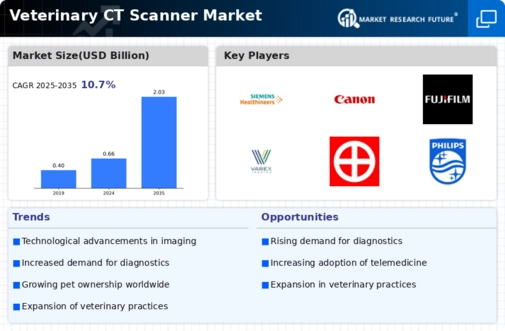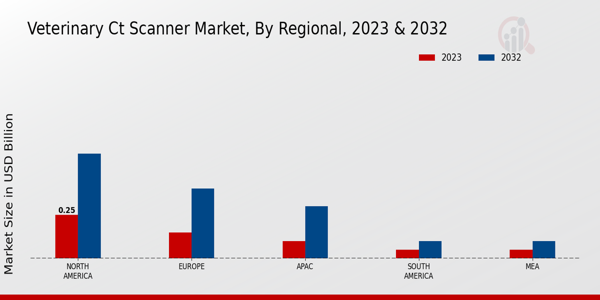Veterinary Ct Scanner Size
Veterinary CT Scanner Market Growth Projections and Opportunities
The veterinary CT scanner market is influenced by various factors that affect its dynamics and growth trajectory as a whole. One of the most important factors driving this market includes increased prevalence of complex animal diseases and rising demand for modern diagnostic tools. As household pets/ animals become indispensable parts of homes, pet owners and veterinarians are increasingly becoming aware of the need for accurate and timely diagnosis. Consequently, there has been a rise in the use of veterinary CT scanners that provide high-resolution imaging to enable precise diagnosis of conditions such as musculoskeletal disorders or internal injuries.
Additionally, technological advancements have been instrumental in shaping the veterinary CT scanner market. The introduction of new imaging technologies like artificial intelligence (AI) integration and machine learning techniques has improved diagnostic accuracy using these scanners. In addition to better patient outcomes, faster results also lead to increased practice efficiency. Therefore, older imaging systems are being replaced with more innovative CT scanners owing to such technological progressions thereby fostering market expansion.
Increased focus on preventive health care in animals is another influencing factor in the veterinary CT scanner marketplace. Pet owners tend to prefer regular check-ups leading to early detection of diseases hence an increased demand for diagnostic imaging instruments. Veterinary care providers are investing in sophisticated equipment like CT scanners because they appreciate benefits associated with early diagnoses for comprehensive healthcare delivery This trend will continue boosting market growth since emphasis on preventive veterinary care will continue increasing.
Global Veterinary CT Scanner Market is also shaped by regulatory factors and standards governing manufacturing and use of medical devices. Compliance with these regulations ensures products safety and efficacy by players in the industry.The stringent nature of some regulations could act as an entry barrier for new entrants but it fosters trust from end-users about their reliability.Hence adherence to those standards becomes critical as a supportive element towards continued business growth that gives positive image within veterinary healthcare sector.
Also impact is felt due to economic determinants which include general healthcare expenditure and disposable income that impacts positively or negatively towards the veterinary CT scanner market. In some regions where there is significant spending capacity on pets’ healthcare, advanced diagnostic tools are likely to be adopted more often. Conversely, during economic downturns or if the veterinary practices and pet owners constrained by finance they might slow down the growth of the market since they would postpone or reduce investment in expensive diagnostic equipment.
Additionally, competition landscape affects the Veterinary CT Scanner’s market situation significantly. The stiff competition among major players encourages continuous product innovation as well as introduction so as to achieve competitive advantage. Market participants engage in strategic collaborations, alliances and mergers & acquisition to increase their dominance within this industry segment. This competitive atmosphere fosters innovation while helping to expand business across all segments, when firms compete for a larger piece of the growing animal diagnostics market.”















Leave a Comment